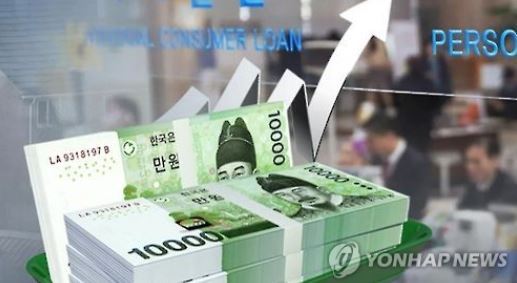Banks post record-high H1 profits on household lending
By Korea HeraldPublished : July 25, 2017 - 17:06
South Korea’s leading banks last week posted record-high first-half earnings, attributing the result to the economic recovery, cost savings, structural improvements and success in nonbanking sectors.
But their positive performance was mostly due to an increase in interest rates, a factor weighing on the nation’s households as debt levels continue to rise.
The rates for business loans, in contrast, were eased during the period, placing the issue as a task for the Moon Jae-in government in its moves to narrow the socioeconomic gap.
According to data released last week, the country’s top four banking groups posted combined net profit of 5.88 trillion won ($5.27 billion) during the first six months of this year.
Shinhan Financial Group topped the list with 1.89 trillion won, followed closely by rival KB Financial Group at 1.86 trillion won.
Both front-runners set new six-month profit records since setting out as financial groups in 2001 and 2008, respectively.
But their positive performance was mostly due to an increase in interest rates, a factor weighing on the nation’s households as debt levels continue to rise.
The rates for business loans, in contrast, were eased during the period, placing the issue as a task for the Moon Jae-in government in its moves to narrow the socioeconomic gap.
According to data released last week, the country’s top four banking groups posted combined net profit of 5.88 trillion won ($5.27 billion) during the first six months of this year.
Shinhan Financial Group topped the list with 1.89 trillion won, followed closely by rival KB Financial Group at 1.86 trillion won.
Both front-runners set new six-month profit records since setting out as financial groups in 2001 and 2008, respectively.

Woori Bank and Hana Financial Group also surpassed 1 trillion won in net profit.
The top four players’ net profit in the banking sector stood at 4.34 trillion won, up 1.95 trillion won or 33.7 percent from the same period last year.
Their record-breaking business performance came while the nation’s total household debt reached nearly 1,400 trillion won as of the end of June and the lending interest rate continued to rise.
All key banks have seen a visible rise in their net interest margins, a leading indicator of banking profitability. In the case of KB Kookmin Bank, the flagship unit of KB Financial, the corresponding figure rose by 0.11 percentage point from 1.61 percent in the fourth quarter last year to 1.72 percent in the second quarter this year.
Mostly boosting the banks’ profitability in interest earnings were households, which had to bear higher interest rates than businesses.
According to industry data, the average lending rate for household loans as of the end of May was 3.47 percent, 0.02 percentage point higher than that of corporate loan interest rate.
This was the first time in seven years and two months that the household lending rates were higher those of corporate loans.
The deposit interest rates of the top four banks, in contrast, continued to stay in the 1.1-1.4 percent range, according to data from the Korea Federation of Banks.
It was under such circumstances that Financial Supervisory Service chief Zhin Woong-seob in May summoned bank leaders for a meeting, strongly demanding they increase their risk management capacities.
Also, banks are likely to face a stronger set of regulations on their lending standards as the government is slated to come up with a new household debt countermeasure as early as next month.
Meanwhile, taking guard against the possible moral hazards of banks, financial authorities are to carry out a reinforced set of supervisory rules concerning the payment of bonuses.
Starting from September, financial companies will have to split their profit-sharing bonus into four yearly payments and cut down on future payments or even scale back from past payments, in case additional losses occur.
The new regulation aims to push financial companies’ chiefs to focus on the sustainability of their businesses rather than short-term performance for the sake of incentives.
Often triggering public debate, huge incentives have been paid out to financial CEOs and chairmen after successful quarterly or yearly performances.
Last year, former Shinhan Financial Group Chairman Han Dong-woo received some 838 million won in performance-based incentives, which accounted for a majority of his 1.57 billion annual income.
By Bae Hyun-jung (tellme@heraldcorp.com)
-
Articles by Korea Herald


![[AtoZ into Korean mind] Humor in Korea: Navigating the line between what's funny and not](http://res.heraldm.com/phpwas/restmb_idxmake.php?idx=644&simg=/content/image/2024/04/22/20240422050642_0.jpg&u=)
![[Exclusive] Korean military set to ban iPhones over 'security' concerns](http://res.heraldm.com/phpwas/restmb_idxmake.php?idx=644&simg=/content/image/2024/04/23/20240423050599_0.jpg&u=20240423183955)



![[Graphic News] 77% of young Koreans still financially dependent](http://res.heraldm.com/phpwas/restmb_idxmake.php?idx=644&simg=/content/image/2024/04/22/20240422050762_0.gif&u=)
![[Herald Interview] Why Toss invited hackers to penetrate its system](http://res.heraldm.com/phpwas/restmb_idxmake.php?idx=644&simg=/content/image/2024/04/22/20240422050569_0.jpg&u=20240422150649)






![[Exclusive] Korean military to ban iPhones over security issues](http://res.heraldm.com/phpwas/restmb_idxmake.php?idx=652&simg=/content/image/2024/04/23/20240423050599_0.jpg&u=20240423183955)



![[Today’s K-pop] Ateez confirms US tour details](http://res.heraldm.com/phpwas/restmb_idxmake.php?idx=642&simg=/content/image/2024/04/23/20240423050700_0.jpg&u=)